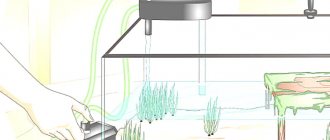Damage from rodents in a chicken coop
The rat is an intelligent and complex animal. She is able to defeat a cat and injure a dog. And in the chicken coop she is calm, safe and has something to enjoy. For permanent residents - chickens, rats pose a particular danger because they:
- They carry dangerous infections that affect not only birds, but also humans. Birds are infected with helminths, fleas and ticks. They eat food from trays consisting of grains, root vegetables and vitamin supplements. Rats steal eggs from the chicken coop, considering them a delicacy. Hatched chickens and young animals are killed. They cause harm to the health of adults by biting off scales on their paws during sleep, which leads to stress in the birds, and this, in turn, negatively affects egg production and weight gain.
Rats are not stopped by strong walls and concrete foundations. In the hunt for food, they gnaw passages, make tunnels, and get to the delicacies that are in the chicken coop by any means. It’s amazing how rats steal eggs.
Damage caused by rats
Rats are a real problem for households. If there is only one individual living in a chicken coop, the problems can be serious, but if there are several, it is difficult to even imagine what they are capable of.
You can expect a lot of trouble from rats:
- They eat and spoil eggs.
- They attack chickens.
- They can infect birds with dangerous diseases.
- Subsequently, the diseases are transmitted to the owners.
Protecting the chicken coop from rodents. Watch this video on YouTube
Difficulties in fighting rats
People have been fighting them for a long time. They get rid of rodents in different ways. That is why rats have developed many methods of defense and the ability to survive in any conditions. Do not underestimate the mental abilities of animals, which also complicates the fight against them.
Rats sense danger and behave very carefully. They deftly bypass prepared traps and warn other individuals about them. Their intelligence is also evidenced by the fact that rats steal eggs from the chicken coop (photo posted in the article). Experts say that they do not abandon their elderly relatives and take care of them, and teach the young to hunt and avoid danger. Therefore, when choosing methods of rodent control, all these nuances should be taken into account. A person will have to use cunning and ingenuity to defeat the dangerous pest.
How to get rid of rats using chemicals
Rats are not only harmful and dangerous animals, they are also cunning, which complicates the process of fighting. Control methods such as setting traps are not always effective, since rats easily bypass them. They will always find a loophole into the chicken coop, even if it is equipped with a strip concrete foundation. These pests easily make a dig, after which they enter the room and do their dirty work. However, their nest may be located in a completely different place.
Over the course of many centuries, man has been able to come up with quite reliable ways to protect poultry and get rid of rodents. There are rat-catching cats, but it is very difficult to find such a hunter. Regular house cats don't want to catch mice, let alone rats. Therefore, we have to resort to traditional methods of struggle, as well as the use of chemicals. The most important thing is to start the fight in time so that the rat does not have time to “clean up order” in the chicken coop.
Toxic substances are used only in extreme cases when rodents cannot be controlled. There are ultrasonic repellers, but they do not act so quickly. During this time, rats can cause serious damage to the owner.
On a note! Since there is poultry, toxic substances must be used very carefully, otherwise chickens can be poisoned along with the rats. The poisonous bait is placed so that poultry, including pets, cannot reach it.
How to Protect Chickens and Pets from Poisonous Bait Poisoning
Pets and birds often die after they manage to reach the bait. Therefore, it is very important to protect them from chemicals. Many owners use one suitable method that does not require any time or money. To make the necessary device, you will need materials that can always be found on the farm, plus, you will have to spend very little time. Despite the simplicity of the device, with its help you can protect yourself from troubles.
Stages of manufacturing the device:
- Take a wooden box. It is better if it has a lid that opens so that it is convenient to place the bait.
- Holes 8-10 cm in size are made on all sides of the box so that rats can easily get inside the box.
- Cats, dogs, chickens and children will not fit into such a hole.
- A wooden box with bait can serve as an additional perch for chickens.
Many owners use chemical control agents because they act quickly and effectively. At the same time, care must be taken to ensure that toxic substances cannot be tasted by pets and birds. If you have such confidence, then you can safely begin the operation to exterminate rats.
how to deal with rats. rats in the chicken coop. Watch this video on YouTube
Means "Goliath"
Technical data:
- An effective drug that has the function of mummifying dead animals.
- This drug is used by special services. The substance is sold in volumes from 1 to 10 kg.
- The action of the drug is based on the fact that when the substance enters the stomach of a rodent, it causes a feeling of oxygen starvation, after which the rodents try to get out of their hiding places.
- After 10-12 days, the individuals begin to die, after which they become mummified. This does not alarm the other rats, and they continue to try the bait, after which they die.
- For 1 kg of a toxic substance you will have to pay 2800 rubles, and for 5 kg - all 9000 rubles.
Carbonation
It is the indoor spraying of substances such as chlorine, hydrogen phosphide and carbon monoxide. This processing method is very complex and requires certain knowledge and skills. Therefore, aeration is used only in large poultry farms. The work is usually carried out by disinfection service employees.
You can use the pollination method. Poisonous powder is scattered on the floor, which sticks to the paws and fur of rodents. Rats are very clean, so they lick themselves often. Thus, particles of powder enter the stomach, causing poisoning and death. This method is very effective, but is not suitable for a chicken coop.
Means "Ratid-1"
Description of the substance:
- An effective product is produced in Ukraine and is intended for use in both non-residential and residential premises.
- Available in granule form.
- One package (40 granules) is enough to rid the chicken coop of rats.
- It has the property of mummification, which prevents the decomposition of dead carcasses, eliminates the smell of the chicken coop and makes it impossible for poultry to become infected.
- There is an improved version of the product - “Ratid-2”.
- The product is sold at an affordable price - for 100 g of poison you need to pay 60-70 rubles.
Everyone should know this! Any of the drugs is accompanied by instructions for use. Under no circumstances should it be ignored. A high effect directly depends on compliance with proportions.
Storm
The drug is quite cheap and effective in the fight against rats. Sold in briquettes individually and in sets of 4 pieces. There are also packages with pellets (granular substance) and in containers up to 16 kg.
Mortorat
With the help of this substance you will not have to search for and remove rodent corpses. The drug mummifies them. It differs from other baits in its high efficiency and safety of use.
Appearance: a briquette with a gel-like substance, carefully packed so that there is no contact with the skin (it is better to use gloves when working).
A hole is laid in the hole and then sealed with plaster or cement. There will be no one left to damage the walls.
Rat death
Purpose: large-scale persecution of all types of rodents. The Italian manufacturer guarantees quick freedom from pests.
Sold in two versions. Difference in composition:
- first option: the main component is brodifacoum;
- second type: the basis is bromadiolone.
Ratindane
The bait is effective. Used only in combination with additional ingredients (food). Methods of use: pollination, dilution in liquid or with food.
Destruction of chicken eggs by rodents
Can rats steal eggs from a chicken coop? It turns out they can, and they even have several ways. They act:
- One at a time - they take the egg with two front paws, and move with the help of their hind paws, crawling. In twos, one grabs the prey and turns over on its back, while the other drags it by the tail to a secluded place.
It is noted that rats store stolen goods in a certain place and feast on them when the product goes rotten. Now you know how rats steal eggs and ruin their owner. Moreover, these animals move not only on the floor, but also on the walls and ceiling.
How rats steal eggs
The rat is a very dexterous and intelligent animal. These rodents love to feast on chicken eggs, but chicken coop owners do not immediately notice the presence of an uninvited guest. They steal eggs at night, just when the chickens are sleeping and cannot see anything. The animals do this very quietly and unnoticed, leaving not a single trace.
There are two most popular theories about how rats carry eggs out of the chicken coop.
The first says that the rodent holds the egg with its front paws, while it moves with its hind paws and, as if crawling, carries away its prey. This is all simple and banal, but quite possible.
The second is more interesting and says that rats steal eggs not individually, but in groups. One of the animals lies on its back, places the egg on its stomach and holds it with its paws. Allies drag him by the tail and also help hold the egg. Thus, the egg is transported on a kind of “living cushion”, which protects it from damage.
Methods for getting rid of rats
Before you start fighting rodents, you need to think carefully and choose the most suitable methods. There are five main ways to get rid of rats, these include:
mechanical – involves the use of traps; chemical - using insecticides; biological - the safest and most frequently used; folk - time-tested without harm to chickens; modern - the use of ultrasonic repellers.
Each method has its own positive and negative qualities. Depending on the specific conditions, you can choose one of them or use several at once.
Cats and dogs
The fight between cats and mice is colorfully described in books, children's fairy tales, cartoons and computer games. It is believed that there is no better way to get rid of pests. In reality, not every cat has a hunting instinct. Many feline pets are afraid of rodents, especially large and cruel rats, which themselves can attack their catchers. The cat teaches its cubs to hunt in practice, which is impossible in home breeding conditions, which is why city cats most often do not know how to catch mice.
To hunt, you need a village cat who has spent his entire life on the street. However, even such “beaten by life” pets often do not dare to attack a rat. What to do in this case? Get a dog. Dachshunds, Fox Terriers and Jagd Terriers are excellent rat hunters, bred specifically for this purpose. Breeds that are not intended for hunting, but for other purposes, as well as mongrel dogs, most likely will not be able to crush rats that steal eggs.
Source
Poultry house reconstruction
The main purpose of a chicken coop is to keep the birds comfortable and to protect the premises from pests. This should be taken care of at the stage of its construction or during operation. Remembering how rats steal eggs, showing their agility, you need to create unfavorable conditions for them. Since there is plenty of food in the chicken coop, you need to be concerned about its tightness. For this:
- When building a chicken coop, place a concrete foundation under it. Make the walls impenetrable. Rats are able to penetrate through a very small hole, so it is advisable to cover the side surface of the building with metal sheet to a height of at least a meter.
Install metal doors so that there are no gaps. The windows should be glazed and the floor concreted; the rats will gnaw through all other materials and insulation. Keep the room clean. Systematically remove droppings, monitor the hygiene of food trays, and collect eggs in a timely manner.
Having eliminated the access of rodents from the outside, you can start exterminating them inside: yourself or invite specialists.
Precautionary measures
To prevent rodents from appearing in the poultry house in the future, you need to build it correctly. It is best to make a foundation for the chicken coop. At the stage of this creation, you should add broken glass to the concrete or lay it out in the corners, and then make a screed. When a poultry house is built without a foundation, on supports, it is necessary to deepen the iron sheets around the perimeter. The depth of their digging into the ground is no more than 30 cm.
Since rodents most often enter the poultry house through digging in the ground, such obstacles encountered along the way will be able to stop them. If, during periodic inspection, you find cracks or holes in an existing chicken coop, you must concrete them.
Mechanical methods of struggle
Can rats steal eggs? Yes, they can and do come up with clever ways. The owner of the chicken coop can suffer significant damage, so it is imperative to fight them. For this purpose, mechanical traps are used, inside which bait is placed.
They are installed in places inaccessible to hens and chicks so that they are not caught instead of rodents. And cunning rats can bypass them. Glue traps are often used, which are ineffective for strong adults that can tear their paws off the smeared surface. Another drawback: the rodent remains alive and must be destroyed or released by someone.
Preventive measures against the appearance of rats
Try to carefully inspect the entire room
A far-sighted farmer must anticipate the danger of rodents and take preventive measures even at the stage of building a chicken coop. This will be of great help in protecting the chickens when rats are invading their home.
Chicken coop walls and floor
During construction, it is recommended to adhere to the following recommendations:
- The floor of the room must have a concrete base.
- To build walls (or at least parts of them half a meter from the ground), it is best to use brick - it is much more difficult for pests to get through such a barrier than through wood.
- The bottom of the walls must be sheathed with sheet iron and preferably so that each sheet goes deep into the ground.
- It is better to cover the foundation of the chicken coop with fine mesh galvanized mesh or lay it under a layer of plaster if the walls will be treated with plaster.
- There should be no voids in the floor and walls; any cracks and holes must be carefully sealed with glass wool and cement with the addition of broken glass.
- When installing doors, you need to make sure that they close as tightly as possible.
.
Rat poison
Even if the rats have not yet visited the chicken coop, there is a reason to purchase and place rat poison in advance in places inaccessible to chickens and other domestic animals.
Even if the rats have not yet visited the chicken coop, there is a reason to purchase and add rat poison in advance
Such a means of defense will help destroy at least some of the rats trying to get into the house and scare away their relatives.
Glass and crushed stone
A mixture of crushed stone and glass is a common and effective method. This mixture is used at the construction stage when laying the foundation.
Crushed stone is mixed with a large amount of broken glass and poured into the foundation. After this, it is filled with concrete, into the solution of which broken glass is also added. A rat can overcome ordinary concrete, but it will be difficult for it to fight glass.
A mixture of crushed stone and glass is also laid out on the ground around the perimeter of the entire chicken coop. A solid layer at least 15-20 cm wide will become a serious obstacle to pests.
The mixture can also be placed in the chicken coop itself - it is safe for the rough skin of chicken feet.
Biological methods
This method of struggle deserves special attention. It is effective and does not require the use of harmful substances. To do this, get a dog or cat that can catch rats. Not all pets are capable of destroying them, so it is advisable to first ask which ones will be useful for this role. In addition to animals, they use plants that have a strong odor that is unpleasant to rodents. These include: elderberry, mint, chamomile, wild rosemary. They are planted near the chicken coop or twigs are laid out near animal burrows. The good thing about this method is that rodents leave places that are unpleasant for them, and there is no need to bother with corpses.
Science doesn't know how rats steal them
Recently, the famous naturalist John Burroughs was asked the question: how do rats transport stolen chicken eggs? Burroughs was forced to admit that he did not know the answer. He knows the existing explanations, but he cannot say which one is correct.
Thousands of North American farmers constantly face this mysterious phenomenon. For example, a housewife collected eggs from her laying hen in a basket and put them underground to sell them at the market the next day. The next morning it turns out that they have disappeared without a trace. Another example. A teenager working on a farm estimated that a hen hatched 15 eggs. A few days later, he sees that there are already 13 of them, but there are no broken shells anywhere to be seen. Another day later - 12. Two more days later - 10.
Folk remedies
If mechanical and biological means are ineffective, you can try folk remedies:
- Wood ash. It is scattered along the walls. It does not pose any danger to chickens, but the alkali present in it corrodes the paws of rats. It is activated when the rodent begins to lick its dirty paws. The appearance of discomfort forces them to leave the coop. A mixture of flour, alabaster, sugar and lime. Rats like its taste, but once inside, it causes organ burns and the rodents die. Barrel of water. It should be filled halfway with water, and pieces of lard should be placed on the surface. Place boxes near the barrel, making a kind of ladder out of them so that the rats can get to the treat, the smell of which they can smell well. All that remains is to collect and dispose of the corpses of drowned rodents.
Can rats steal eggs from a chicken coop?
Yes, rats steal eggs from the chicken coop. I personally saw a picture of how they do it:
The rat holds the egg with two legs, walks along the floor with its hind legs, and holds prey with its front legs, but does not move standing, but crawling. In the same way, the rat began dragging the egg along the ceiling! She held the egg with her two front paws and crawled along the ceiling with her back paws. How is this possible? It’s simply incredible, if I hadn’t seen this in person, I would never have believed it.
Why did rats steal eggs? Most likely because of the chickens inside, since they only stole from us the eggs that were under the hatch. We learned about the thieves because of the chickens; the birds made such a fuss when the rats raided that we had to go to their chicken coop to investigate. The kitten was then taken into the house and the rats were poisoned.
Of course, rats are very smart animals and they steal eggs in a smart way, and they steal not alone, but in a group, one grabs the egg with its paws and turns over on its back and clasps the egg, and the other pulls this cart by the tail into its hole, if you disassemble the floors in a chicken coop, you can find a bunch of eggs, rats don’t eat fresh eggs, they wait until the eggs go rotten, but they not only steal eggs, but also spread all sorts of infections, which is why the chickens then start to get sick, and if the rats are really hungry, then they can kill chickens, and also these smart creatures, in my chicken coop, they dug holes in each nest, and when the chicken sits down to lay eggs, the egg carefully falls into this hole and does not break, because there at the bottom of the hole the rats dragged sawdust, and the egg fell , I couldn’t get it, but the rat quickly dragged it away under the floor. Fantastic, I am amazed at their cleverness.
Source
Chemical method
To the question of whether rats steal chicken eggs, there is only an affirmative answer. Therefore, it is imperative to get rid of rodents in the chicken coop. Insecticides, the range of which is very large, are suitable for this. But it is important to remember that pesticides are not safe for birds. Therefore, when using them, the chicken coop is cleared of its inhabitants for a while, moving them to another room. Gaseous preparations are considered the most effective means, but to use them you need to invite a specialist.
When treating with chemicals, you should always remember that rats can develop immunity to them. It is best to use new drugs that have just appeared on the market. They do not have an immediate effect, so it is necessary to remove the corpses of pests in a timely manner.
What kind of rats are human neighbors?
Rats love and often steal chicken eggs.
There are currently more than 70 species of rats. Among them there are those that live only in certain regions, like marsupial rats in Australia.
There are representatives who are pets. Some break records with their size. The rodents are even trained and hired into service, like Gambian hamster rats.
On the territory of Russia and its environs, two types are most often found:
- black rat;
- gray rat Pasyuk.
Ultrasonic repeller
Such devices are sold in any hardware store and are one of the most humane ways to control rodents. The device produces sound waves that are not detected by the human ear, but cause panic and anxiety in rodents, and they urgently leave the room. To select an effective rat repeller, professionals advise paying attention to the following details:
- Power. When choosing a device, take into account the range of action. Scene. Ultrasound only travels indoors. Safety. The device must operate in the absence of people. Change of vibrations. To scare away rats, the oscillation frequency changes automatically so that they do not get used to it.
Using repellent ultrasound
Modern progress offers such an innovation as ultrasound, with the help of which animals are scared away from the chicken coop. Ultrasonic waves operate at a frequency that rats can detect. It affects the hearing of animals, causing panic and fear, as a result of which the animals leave their usual habitat.
For such protection to work, you need to keep the device constantly on in the chicken coop. Most of these devices operate in economy mode and consume little electricity.
Rats in the house and how to get rid of them
Good afternoon, experienced and novice poultry farmers. When raising poultry and other domestic animals, it is not enough to take good care of them - feed them, keep the poultry house and other agricultural premises clean. Rats often appear near these buildings. In this case, it is extremely difficult to keep your animals and birds from being damaged or killed by these rodents. Rats in a poultry house destroy birds and chicks, infect living ones with various diseases, and then can get into people’s homes.
Protecting your agricultural buildings from the invasion of these rodents is a serious task, but it can be overcome if you know the methods of getting rid of rats.
Prevention measures
Reconstructing the chicken coop and observing basic sanitary standards will help get rid of rats forever. Food should be stored in metal boxes where rodents cannot get into. The daily diet of birds should not be excessive, so that at night the animals have nothing to eat.
Timely cleaning of the premises and its inspection for the appearance of rat passages will help prevent the proliferation of pests. You can fill the holes with crushed stone mixed with broken glass and seal them with a building mixture. If the rodent has experienced pain, it will no longer appear in this place.
Why do rats appear in the poultry house and in the yard?
Rats never appear on the site without a reason. They are very cunning and intelligent, they quickly get used to the poison used, and this is what distinguishes them from other rodents and pests. Often you have to fight with them for months. However, this can happen due to the fact that a person has chosen the wrong methods of struggle in a particular room.
The appearance of rats in the poultry house and on the site depends on:
- Conditions of the poultry house where the flock of chickens is kept;
- from the conditions in the yard;
- the presence of other sheds in your yard and neighbors.
If there is chaos in your neighbors’ yard, there is no order in the barns and other buildings, then perhaps the “rat house” is located there, and they come to your poultry house to feast on eggs or poultry meat. Finding a place where rats live is not easy. They often dig deep and long passages up to 0.5 km long.
Lack of cleanliness in the poultry house, the smell of stale food, droppings - these are the reasons why the “aroma” from the poultry house can spread over long distances. And these rodents immediately sense this smell and rush to it in anticipation of food. Having been in the house, the rat immediately determines food supplies, possible dangers and threats.
Next, about the damage caused by rodents.
The main reasons for the appearance
Smart animals, when choosing a place where they can safely live and breed, take into account many factors. Therefore, the chicken coop is an ideal place for them:
- Variety of food products. Here you can not only stock up on grain and feed, but also enjoy eggs. Adult rats may well attack chickens.
- Suitable air temperature and humidity. Both birds and rodents have completely the same preferences in this matter, therefore, the more caring the owners of chickens, the more comfortable it is for rats and mice.
- The ability to easily enter the premises through various openings for chickens. And if the structure does not have a solid foundation, then making holes by digging is as easy as shelling pears for rodents.
Rat
Sometimes rodents take up residence with neighbors and only visit the poultry house for food. This happens if owners seek to protect their farm from rodent infestation.
What harm do rats do in a poultry house?
The more often this gray “guest” appears in the chicken coop, the more traces of his presence he will leave.
These predators reproduce quickly - each female can give birth to up to 49 rat pups in a year - and gradually begin to move to new places. And the more of these gray “guests”, the more damage they will cause. In addition to eggs and meat, rats will gnaw walls and floors, and “enjoy” food supplies, hay, and compost. But the worst thing is if this rodent infects with intractable diseases.
It is believed that the rat happily eats all its food raw. But most of all they like chicken eggs, which contain many useful substances necessary for all living beings. And the disappearance of one or two eggs is not so noticeable in the nest.
Also, rats in the poultry house often drag eggs into their hole and store them “in reserve.”
Rats eating chickens
Rats take care of their offspring, bringing them any “delicacies”. And the best of them is the meat of recently hatched chicks. A rodent can strangle a chicken and drag it into its hole, where the pups will quickly eat this delicacy.
The rodent senses the meat of chickens from afar and is capable of strangling not only newborn chicks, but also older chickens. If measures are not taken in time, then in a couple of days the rat will pull out the entire brood.
How rodents can harm birds
The appearance of mice and rats in the poultry house is already a danger. These nocturnal predators can carry helminth eggs and scabies mites on their fur.
In addition, the animals are carriers of various infections, such as plague, rabies and leptospirosis. It is imperative to fight them; in addition to various diseases, rats destroy everything in their path, eat small chickens, gnaw through power cables, make holes in concrete, damage wood and other building materials.
Animals can easily determine that they are being hunted. Rats have a special sense of smell; they bypass established traps in other ways and remain unharmed.
Some scientists believe that animals can understand each other, which is how they communicate about danger. These animals lead a special way of life, care for old relatives, and also teach young people to identify the location of traps.
Humanity has been fighting rats for a long time, because they steal chickens and eggs.
Despite the advent of modern traps and baits, as well as other means, many poultry farmers carry out the fight using old antiquated methods. We will describe in detail the most popular methods of combating small predators.
Every birder knows about the ability of cats to hunt mice and rats, but not every animal can be used for such purposes.
Modern domestic cats have become very lazy; many breeds are bred for decorative purposes, and not for catching rodents.
Rat-catching cats are found quite rarely, and they also have a peculiar disposition. Despite this, pests can also be repelled by the smell of a cat.
Biological control methods include exposure to certain plants. Parasites are most afraid of the smells of elderberry or peppermint leaves. Raw materials from such plants can be bought at the nearest pharmacy or collected yourself.
When using mint infusion, it is necessary to soak a piece of cloth with this liquid, which is then placed in a mink. After such aromatherapy, the animals will leave the chicken coop.
If elderberry is used, then its branches must first be chopped and scattered on the floor of the chicken coop, and also stuffed into the holes.
If a large number of harmful animals are found in the chicken coop, it is necessary to use more effective chemical methods.
At the moment, this method of control is considered one of the most popular; it involves the use of pesticides. Despite its considerable popularity, the chemical method does not always give the expected effect.
In addition to rats, birds can also suffer from spilled poison, so the poison must be scattered carefully in places inaccessible to chickens. And one more disadvantage in favor of using chemicals is that animals quickly develop immunity to popular poisons.
Another disadvantage of using pesticides is the need to collect the corpses of dead rodents, and this is not a very pleasant experience. Chemicals must be used several times in a row to kill adult rats and their offspring.
This method of capture involves the use of traps, special glue baits and rat traps.
The main goal of hunting is the correct placement of baits so that chickens do not get into them. Pests most often pass near nests with eggs, but installation in these places is problematic. In most cases, rodents bypass baits.
Mechanical methods also include homemade rat traps. The simplest device can be made from a simple bottle.
Pour a little sunflower oil into the container and then shake it so that the liquid is evenly distributed over the walls of the container. For greater effect, put a piece of lard or sausage into the bottle.
This is interesting:
- Do-it-yourself chicken feeders made of wood Garden decoration - a do-it-yourself bird feeder In winter, it is not easy for birds to find food under the snow. You can help them by making a bird feeder with your own hands. Attract to [...]
- Chicken coop normal Conditions for keeping chickens In optimal, i.e., the most favorable conditions of keeping and feeding, poultry of highly productive egg and meat-egg breeds can produce […]
- Floor in a chicken coop from rodents How to get rid of rats in a chicken coop? A very unpleasant event is the appearance of rats in the chicken coop. In addition to the fact that they crush chickens, they spread diseases (scabies mites, helminth eggs, plague and […]
The main advantage of such a rat trap is the ability to use it anywhere in the chicken coop. Such a trap will not harm the chickens, but a mouse or small rat can easily get into the bottle, but will not get out.
Her paws will slide along the surface of the container. To catch large animals, it is recommended to use a bottle with a large neck.
Night predators have been harming chickens and other poultry for many years, so craftsmen have come up with a lot of ways to get rid of these dangerous pests.
One of these methods is to sprinkle holes with ordinary wood ash. This substance contains alkali in large quantities, which will corrode the legs of predators during hunting.
Rats will lick the ash, but it will enter the oral cavity and esophagus and lead to the destruction of soft tissue and the possible death of the animal. The second folk method of getting rid of pests involves making a special dish that contains flour, lime, sugar and alabaster.
It is difficult for a hungry animal to refuse such a treat, but after ingestion, lime will begin to destroy the esophagus, alabaster will lead to blockage of the intestines and further death of the pest.
You can drive away pests as follows. We take a caught rat, put it on a shovel, pour gasoline or alcohol on it and set it on fire.
With this carcass you need to walk around the chicken coop several times. It is believed that rats do not tolerate the smell of their fallen relatives well, they will be forced to leave the chicken coop for a while.
There is another popular folk method of exterminating pests. To implement it, you need to catch 10-20 live rats and place them in a closed container.
After some time, the animals will feel hungry and begin to eat each other. As a result of natural selection, the strongest animal will survive and adapt to the meat of its relatives. This rat needs to be released into the wild, where he can destroy the entire population.
Ultrasonic repellers
One of the most common methods of control is the use of an ultrasonic repeller.
This device has a mild effect on animals; its ultimate goal is not destruction, but scaring away animals.
When the described device operates, frequency vibrations are created that cannot be felt by the human ear and poultry, but the sounds produced are considered unacceptable for rodents.
As you know, rats can get used to various unfavorable conditions, but the ultrasonic repeller is designed in such a way as to change the oscillation frequency. This will prevent pests from getting used to it, and the device’s coverage area is quite large.
How to determine that there are rats in the poultry house?
If you start fighting rats immediately after the first signs of their presence in the chicken coop are noticed, you can get rid of them with virtually no harm to the poultry flock. First of all, you need to constantly monitor the condition of your entire household, including domestic animals and poultry.
The first symptoms of the appearance of rodents in a chicken coop are restless behavior of the flock for no apparent reason, a decrease in the number of eggs laid in the nests. Over time, smothered chickens may appear in the chicken coop, as well as a specific “aroma.”
Having noticed such symptoms, it is necessary to regularly disinfect the premises, as well as regularly inspect the poultry house. From this moment on, the main task of the poultry farmer becomes the destruction of gray pests.
Presence of rat droppings
If droppings appear in a room with chickens - elongated, dark brown and larger than those of mice - this is a sure sign of the appearance of rats (at least one) in the chicken coop. It can usually be seen in corners or near food.
Need to know! Mice can never live near rats. Therefore, if the latter suddenly disappeared from the area, this is a sure sign of the appearance of a rat family nearby.
In this case, you need to get together with your neighbors and outline ways to exterminate rodents.
The appearance of new holes
Rats in poultry houses and barns never make one hole in wooden buildings and constantly gnaw new ones in order to have additional escape routes. Therefore, every day new holes will appear in the poultry house in the most unexpected places (even in the ceiling).
Smothered Chicks
In the first 12-14 days, the rodent settles into the chicken coop, prepares escape routes, and gnaws holes in different places. Then he slowly begins to take over - he eats eggs, the decrease in the number of which at first the owners attribute to a decrease in the egg production of chickens. But then she begins to strangle the chickens and take them to her holes.
But sometimes she does not have time to drag away the strangled bird, in which case the owners notice the dead chickens - in this case it is time to sound the alarm: set traps, traps, scatter poison to deal with the gray pests.
Wire damage
Very often (in about 2/3 of cases) problems with electrical wiring occur on the site and in the premises due to the presence of rats. They chew through the wiring, as a result you have to look for a break and repair it.
Specific "aroma"
A new “aroma” appears in the room - a cloying one, in which a hint of ammonia is clearly felt. This aroma is more noticeable in corners or in places where ventilation is poorer.
How to protect a chicken coop from rats entering it?
It is important to remember that even if the rats were successfully removed from the chicken coop, it is necessary to provide protection against their re-entry. Otherwise, you will have to fight rodents regularly.
As a rule, to prevent rats from getting into the coop, it is enough to:
- Strengthen the earthen floor - remove a 40 cm layer of earth, fill in 30 cm of expanded clay and lay a fine mesh metal mesh (preferably with cells no more than 5x5 mm) over the entire area, then fill the earth back. It is important to ensure that such a barrier on the floor is no lower than the base of the foundation of the chicken coop, otherwise there will be little point in these measures;
- Or you can make a normal concrete floor, which will be sprinkled with sawdust or sand on top;
- You should also caulk all the cracks in the walls and roof through which rats can enter the chicken coop, caulk the joints between the walls and the foundation of the building, and ideally, make full-fledged stone walls. Even a half-brick wall will be an insurmountable barrier for a rat.
Of course, it is also necessary to keep the chicken coop clean - in this case, it will be easier to notice traces of rat activity, for example, broken eggs and rat excrement. The latter, by the way, is the easiest way to establish the presence of rodents.
On a note
Rat droppings are dark in color, reach 10-14 mm in length and are usually located in small piles. The simultaneous presence of large and small excrement already indicates the presence of some population of rodents (large and small animals).
Other telltale signs that should make you start dealing with rats as soon as possible:
- ammonia odor, especially strong in closed places;
- chewed surfaces – the constant growth of teeth forces rats to taste literally everything;
- “treadmills”, which are traces of rodent movement visible in dusty places.
And even more so, holes made at the junction of the foundation and walls, as well as eggshells next to them, clearly indicate that pests have gotten into the habit of dragging eggs here, and you need to start fighting them as soon as possible.
Interesting video: an example of how a cautious rat hunts in a chicken coop
How to deal with rats in the chicken coop and on the property?
There are many methods for exterminating rats in areas and indoors that are almost 100% effective. These can be proven folk remedies or various chemical preparations.
But the most effective method is to call a special service that deals with the extermination of rats in any premises. This service is quite expensive, but it works flawlessly - the rats are completely destroyed.
All preparations used by exterminators do not harm poultry, animals or people, but are designed only to kill rodents. However, this service is quite expensive, so farmers mostly try to withdraw money using other available means.
Using chemicals
Currently, in specialized stores there is a large selection of pesticides for killing rats. However, not all of them are safe for poultry.
After all, rats, having eaten poison, carry some of it away on their paws, leaving particles of chemicals on the bedding, food - throughout the room, where they will rush about in agony. Therefore, when carrying out such events, the entire poultry population is urgently transferred to another room.
Usually, quick-acting drugs are used to destroy gray pests, in particular - Krysin . However, there are many other baits with poison that are no less effective and act on rodents just as quickly.
Poisonous baits
It is extremely difficult to fight rats, because they have intelligence, can quickly multiply and explore new “lands”. At the same time, their body quickly adapts to the poison, so they have to regularly change pesticides during the fight.
Modern poisonous baits have the ability to disguise themselves as aromas that can attract rodents.
Such products must be used in strict accordance with the instructions for use, and when processing premises, wear protective clothing and other protective equipment so that the poison does not come into contact with the skin.
Such drugs are available in the following forms:
- Granule;
- tablets;
- grains;
- in powder form;
- in the form of gels.
Most drugs are easily soluble in water and can be added to food. But there are products that are ready for use, so they can be immediately put into rat passages.
We must remember! When purchasing chemicals, be sure to check the expiration date of the drug and the availability of instructions.
Recently, those types of poisons that mummify pests have become very popular. After all, poisons do not act instantly, so the rat dies over a certain period of time, after which its corpse, decomposing, emits an unpleasant odor.
Cat or dog as chicken coop protector
Often, many owners of private households keep a cat on their property, but do not allow it into the chicken coop for fear that it will crush the hens or chickens. As a result, the most reliable and effective rat catcher remains out of work, and his owner has to rack his brains about how to deal with rats in the chicken coop.
In fact, cats almost never strangle poultry. Not only chicken owners, but often even pigeon keepers allow their pets to freely enter the dovecotes and catch mice and rats here. In rare cases, when a cat does strangle a chicken, punishing it once is enough to ensure that it does not repeat this in the future.
Therefore, if there is a cat living on the property that has already proven itself as a rat catcher, it makes sense to let it into the chicken coop to hunt for rats. It’s possible that you won’t have to do anything else to get rid of the pests.
Likewise, fox terriers or Jagd terriers happily hunt rats. True, they are less inclined to wait for hours for prey, sitting in a chicken coop, but often these dogs also help their owners get rid of rats without the use of additional methods and means.
Using rat repellers
The use of repellers is more humane than the use of poison. Ultrasonic, mechanical and biological devices are commonly used to repel rodents. At the same time, the inhabitants of the poultry houses do not experience any unpleasant sensations. And rats will not come close to the area where such devices are located.
Ultrasound devices.
Such devices are plugged into sockets, but the ultrasound is not perceptible to humans, and the rats in the poultry house lose the ability to navigate in space and lose their appetite. Because of such inconveniences, these animals prefer to move en masse to another place where there will be no such devices.
Mechanical devices.
Typically, specialized stores offer the following mechanical devices for catching rats - traps or rat traps. Food is attached to special pins, and when you try to take it, a mechanism is triggered and the trap is triggered.
These devices can be safely used indoors. Currently, powerful rat traps are sold, which can catch several rodents at a time. At home, they also use homemade traps by spreading special glue on a solid base in front of the food.
Biological agents.
This method is the simplest of all, except for the need to remove dead animals.
To combat rats, their natural enemies are used - owls or cats. Street cats fight rats more actively - real rat traps have an elongated, pointed muzzle.
Poison in the chicken coop. In no case?
It should be understood that no matter what the poisoned bait for rats is and no matter what it looks like, there will definitely be chickens who will find it and taste it. Moreover, if the owner of the chicken coop himself is not particularly worried about choosing a product. As a result, there are numerous cases of chicken poisoning with rat poison, most of which resulted in the death of the birds.
The main symptoms of chickens being poisoned by rat poison are refusal to feed, lethargy, ruffled feathers, incoordination, trembling, convulsions, vomiting and bloody droppings. These signs may appear immediately or within 1-5 days, depending on the toxic substance.
In cases of poisoning of a large number of birds, it is advisable to contact a veterinarian to provide qualified assistance; in case of isolated poisonings, you can act independently. Your task is to remove the toxin from the body as quickly as possible. To do this, you need to rinse the stomach with a weak solution of potassium permanganate or activated carbon by oral administration (you can use a syringe) in a volume of up to 2/3 of the crop.
On a note
You should not eat eggs or meat from birds that have been poisoned. There are known cases of poisoning by the eggs of such chickens even 10 days after treatment. Depending on the toxic substance, the process of removing the poison from the bird's body can take more than 2 weeks. A veterinarian can give an accurate prognosis.
But let’s return to the considered method of getting rid of rodents in a chicken coop using poison and note another of its inconveniences - the need to search for and collect dead rats in order to avoid infecting domestic animals with pathogens, the appearance of an unpleasant odor, as well as possible eating by their relatives.
As a result, there are only two acceptable ways to exterminate rats in a chicken coop using poison:
- All chickens are temporarily transferred to another room, and poison, for example, “Rat Death” or “Zookoumarin” is laid out in the old chicken coop. The rats die, then the chicken coop is cleaned and the birds return. To implement this method, additional space and about a week or two of time are required;
- Another option is possible - the same box is placed in the chicken coop as for installing a rat trap. A heavy ceramic plate is placed in the box and beer is poured with the addition of liquid poison for rats (Brommus, Bromed, Brodifan, Indan-Fluid, etc.). The principle here is that rats willingly drink beer and smell it well, but they will only be able to eat poison in the closed box itself, where chickens will not get into. The same can be done if you replace the beer with milk, but in this case the process may take longer because the milk does not smell as strong and rats may not immediately detect it.
As in the case of traps, to prevent chickens from eating rat poison, it can be placed in special plastic houses available for sale today, which are analogues of homemade boxes. Here you should also use only liquid poisonous baits that the rats will not be able to pull out of the house. However, in general, these bait stations are quite expensive, and it can be easier to make your own from a cardboard box, which allows you to effectively get rid of rats without additional cost.
Traditional methods of fighting rats
But farmers also have a number of folk methods in their arsenal that can effectively repel these rodents or kill them. The main thing when using such products is that these products are not dangerous for poultry.
Medicinal black root
Animals and birds cannot stand the smell of this medicinal plant, so they avoid the places where the black root is located. Therefore, poultry farmers lay out black root in the corners of the poultry house and around the barns. You can use both fresh and dried herbs.
Ash – wood and stove
Ash has the property of killing rats, so you should temporarily move the poultry to another room, and scatter as much ash as possible in the chicken coop! It sticks to the paws of rodents, then enters their intestines and gradually eats away at it. At the same time, the rats experience severe pain. The death of animals occurs a few days after this substance enters their stomach.
Uses of gypsum and lime
To prepare baits, take gypsum or lime and mix it in equal parts with corn flour. Add milk or kefir to the resulting mixture and roll into small balls. They are placed in places where animals gather or in their burrows. After the balls disappear, you need to add new bait.
How to solve a problem
The first step is to identify the egg eater. To do this, the head, feathers and beak of each chicken are examined. The culprit is identified by traces of dried yolk. If the procedure does not produce results, a dummy egg filled with food coloring is used.
A bird with a colored beak moves to an isolated place. She is returned to the chicken coop only if she gets rid of the bad habit.
After determining the exact cause of the pecking, the necessary measures are taken. There are several options to solve the problem.
If changing the diet and improving living conditions do not have the desired effect, you can use traditional methods. Eggs are replaced with white dummies made of wood, plastic, or salt dough. This method quickly gets rid of a bad habit.
Replacing the contents of the egg helps a lot. The white and yolk are extracted with a syringe. The shell is filled with mustard or a mixture of hot spices. Their taste discourages them from pecking at the eggs.
The article describes simple and effective ways to solve the problem. If they do not bring results, and the bird’s behavior cannot be corrected, it is sent for meat.
Source











